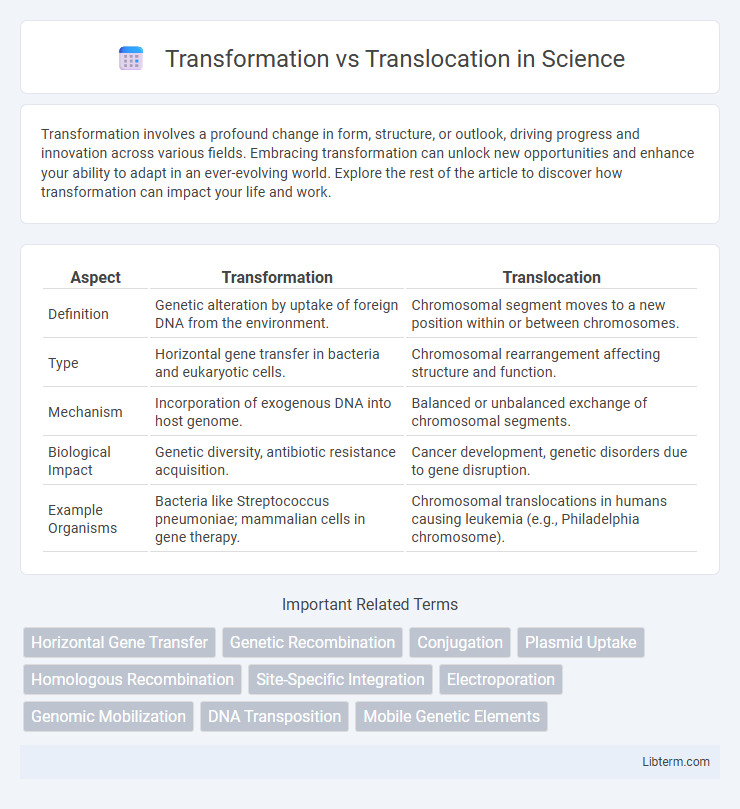Transformation involves a profound change in form, structure, or outlook, driving progress and innovation across various fields. Embracing transformation can unlock new opportunities and enhance your ability to adapt in an ever-evolving world. Explore the rest of the article to discover how transformation can impact your life and work.
Table of Comparison
| Aspect | Transformation | Translocation |
|---|---|---|
| Definition | Genetic alteration by uptake of foreign DNA from the environment. | Chromosomal segment moves to a new position within or between chromosomes. |
| Type | Horizontal gene transfer in bacteria and eukaryotic cells. | Chromosomal rearrangement affecting structure and function. |
| Mechanism | Incorporation of exogenous DNA into host genome. | Balanced or unbalanced exchange of chromosomal segments. |
| Biological Impact | Genetic diversity, antibiotic resistance acquisition. | Cancer development, genetic disorders due to gene disruption. |
| Example Organisms | Bacteria like Streptococcus pneumoniae; mammalian cells in gene therapy. | Chromosomal translocations in humans causing leukemia (e.g., Philadelphia chromosome). |
Understanding Transformation and Translocation
Transformation refers to the genetic alteration of a cell resulting from the direct uptake and incorporation of foreign DNA from its surroundings, a fundamental process in bacterial genetics and molecular biology for gene transfer and expression. Translocation involves the movement of molecules or cellular components from one location to another, often describing chromosomal abnormalities where segments are rearranged between nonhomologous chromosomes, impacting gene function and causing diseases like cancer. Understanding transformation emphasizes the mechanism of DNA uptake and incorporation, while grasping translocation focuses on positional changes within chromosomes or cellular transport processes affecting cellular behavior.
Key Differences Between Transformation and Translocation
Transformation involves the uptake and incorporation of foreign DNA from the environment into a bacterial cell's genome, enabling genetic variation and adaptation. Translocation refers to the movement of a chromosome segment from one position to another within or between chromosomes, often resulting in genetic rearrangements that can affect gene expression or function. Key differences include transformation's role in horizontal gene transfer versus translocation's role in chromosomal structural changes, as well as their distinct molecular mechanisms and biological consequences.
Definition of Genetic Transformation
Genetic transformation is the process by which a cell incorporates foreign DNA from its surrounding environment into its own genome, leading to a stable genetic change. This natural or artificially induced mechanism enables bacteria or other cells to acquire new traits, such as antibiotic resistance or novel metabolic capabilities. Unlike translocation, which involves the movement of chromosomal segments within or between chromosomes, transformation specifically refers to the uptake and integration of external genetic material.
Definition of Genetic Translocation
Genetic translocation is a chromosomal abnormality where a segment of one chromosome breaks off and attaches to a non-homologous chromosome, leading to changes in genetic material distribution. This differs from transformation, a process in bacteria where cells uptake foreign DNA from the environment, integrating it into their genome. Translocations often result in genetic disorders or cancers due to disrupted gene function or regulation.
Mechanisms of Transformation
Transformation involves the uptake and incorporation of free extracellular DNA fragments by a bacterial cell, enabling genetic alteration through homologous recombination or plasmid integration. This process requires competence development, where specific proteins like Com machinery facilitate DNA binding, processing, and transport across the cell membrane. Unlike translocation, which moves molecules across membranes via transport proteins, transformation specifically modifies the genetic composition by integrating external DNA.
Mechanisms of Translocation
Translocation involves the movement of large DNA fragments between nonhomologous chromosomes through mechanisms such as chromosomal breakage and rejoining, often facilitated by faulty repair of double-strand breaks via non-homologous end joining (NHEJ). Balanced translocations exchange genetic material without gain or loss of chromosomal content, while unbalanced translocations result in genetic imbalances due to duplication or deletion. Mechanistic understanding of translocation is critical in cancer biology, as gene fusions from translocation events can activate oncogenes or disrupt tumor suppressor genes.
Biological Significance of Transformation
Transformation in biology refers to the genetic alteration of a cell resulting from the direct uptake and incorporation of exogenous DNA, playing a crucial role in horizontal gene transfer and genetic diversity among bacteria. This process enables the acquisition of new traits such as antibiotic resistance or metabolic capabilities, enhancing survival and adaptation in changing environments. Translocation, by contrast, involves the structural rearrangement of chromosomes, often leading to genetic disorders or cancer, highlighting the distinct biological significance of transformation in facilitating beneficial genetic exchange.
Biological Importance of Translocation
Translocation in biology refers to the movement of molecules or ions across cellular compartments or within organisms, playing a critical role in nutrient distribution and genetic material transfer. It ensures the proper allocation of resources such as sugars and hormones between plant tissues, directly impacting growth and development. This process contrasts with transformation, which involves the uptake and incorporation of foreign DNA into a cell, primarily significant in genetic engineering and microbial adaptation.
Applications in Biotechnology and Medicine
Transformation and translocation hold distinct significance in biotechnology and medicine; transformation involves genetic material uptake by cells, crucial for genetic engineering and recombinant protein production. Translocation, referring to chromosome segment rearrangement, plays a critical role in diagnosing cancers like chronic myeloid leukemia through identification of fusion genes such as BCR-ABL. Exploiting transformation enables advancements in gene therapy and vaccine development, while understanding translocation guides targeted therapies and personalized medicine strategies.
Comparative Analysis: Transformation vs Translocation
Transformation involves the uptake and incorporation of free DNA from the environment into a bacterial genome, enhancing genetic diversity and adaptability. Translocation refers to the movement of genes or chromosomes within or between DNA molecules, often causing structural variations and influencing gene expression. While both processes affect genetic material, transformation enables horizontal gene transfer through external DNA acquisition, whereas translocation results from chromosomal rearrangements impacting genome architecture.
Transformation Infographic

 libterm.com
libterm.com